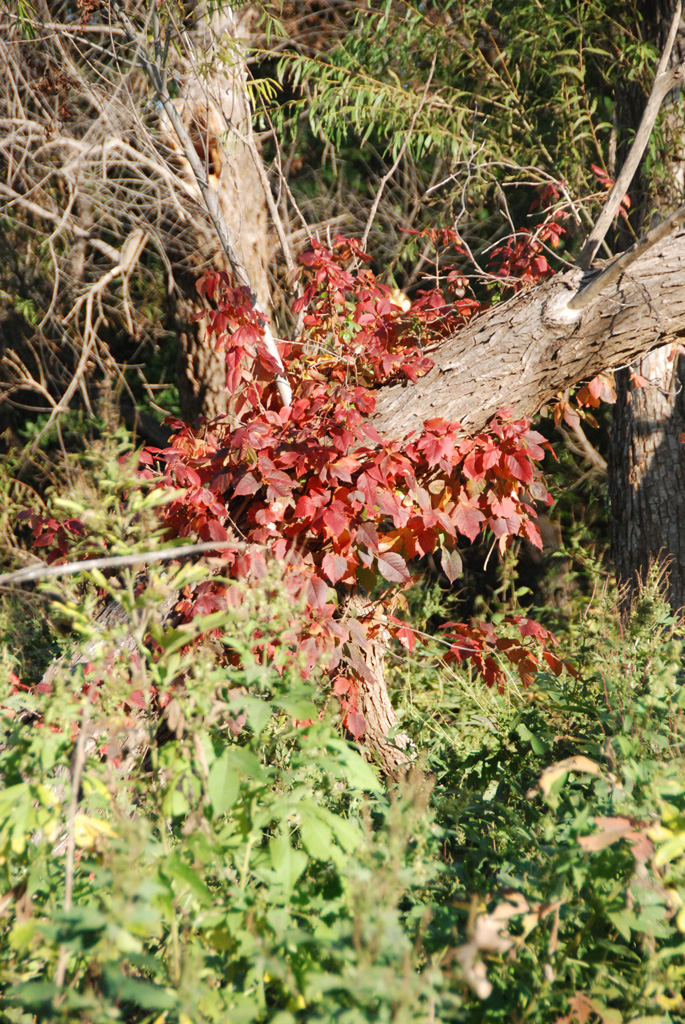Well, I had barely crossed the draw when I saw this young sapling and was glad that I had brought my camera with me....
See that little knot of "debris" near the trunk, a couple of feet above the ground? It's a small birds' nest.
As I've mentioned before, I never go looking for bird nests during the summer, since I feel like I lead predators to their nests when I find them. I've actually become rather superstitious about this and generally won't even photograph a nest if I stumble upon it accidentally. This morning, with the leaves dropping off this young hackberry sapling (Celtis occidentalis), a nest had been revealed that had, presumably, been there all summer long - not 15' off the trail and about 2' off the ground. Despite having obviously walked by this nest numerous times in the last few months, I'd never noticed it or even noted that there was probably a nest somewhere in area...until now.
Even at this point, with all the leaves gone, the nest isn't sticking out like a sore thumb. I have no idea what kind of birds built it or whether or not they were successful in their nesting attempt, but I certainly have my hopes.
As I walked back to the trail from taking the closeup photo of the nest, I noticed this hollow stem sticking up out of the drying grasses....

Looking around, I noticed more hollow stems, then realized that these were old stalks of wild lettuce, Lactuca sp. I've never paid much attention to wild lettuce, assuming that it was an introduced weed and, as such, not of much use to wildlife. Well, when I looked Lactuca up at Kansas Wildflowers & Grasses, I realized that there were 3 species listed, 2 of which were actually native. I know that I have the non-native species (Lactuca serriola or prickly lettuce) on the property, but I don't know if these stalks are from that species or from one of the native species - I've never checked to see if I have the native ones or not, simply lumping all "wild lettuce" plants I've seen into the thought category of "non-native 'weed'."
This is what one of the" freshest" of the wild lettuce plants in the area looks like right now - pretty much dead already - and there are stalks in all stages in between this one and the old, gray ones. I'll have to wait until next summer to check about whether the native species grow on our property or not.
So why do I care? Because, as the holes in these stalks insinuate, something has been living in these stalks and utilizing their innards for food and/or cover. And some of the most common animals to utilize the inside of hollow stems are the native bees, aka native pollinators! So even this very common plant that I had previously dismissed as basically useless turns out to have an important role in a healthy ecosystem.
In fact, as I read a bit more about the wild lettuces, they are actually rather interesting plants. Native Americans used them for several medicinal purposes, including as a poultice for poison ivy rashes. Wild turkey and deer will eat the leaves, even the prickly leaves of the non-native prickly lettuce.
Sometimes I feel like I need a "Jethro slap" to the head!
Despite finding these several new-to-me discoveries in the Cedar Grove, I wasn't in the mood to walk the Back Five this morning, so I walked around the front tallgrass area instead. I haven't walked the front much at all this summer.
For only about the second time this year, I noticed that the cattails in the swampy area along the north part of the draw appear to be gone, at least for now. Here is a photo of this area as it currently appears. There is not a cattail to be found, but the giant ragweed (Ambrosia trifida) and annual sunflowers (Helianthus annuus) grew to enormous heights over the summer and a few panicled asters (Symphyotrichum lanceolatum) moved into the foreground. It should be great winter habitat for the small birds.
I ended up this morning's walk out front by the driveway where I finally took a couple photos of the healthy young Maximilian sunflowers (Helianthus maximiliani) that Melanie of There's No Place Like Home shared with me this spring. I am just tickled pink - they not only survived, which was amazing given that they are planted in a "wild" area of the property and thus didn't get any extra water, but they thrived! Even though the blooms are reaching their end, I still saw numerous insects feeding at them, including 3 different kinds of skippers that were kind enough to stick around long enough for me to photograph them. The most photogenic combination of skipper and sunflower is below:
So my lesson for the day? Be sure to take my camera with me when I walk, no matter how unexciting the day seems, because there's always something new if I keep my eyes open.























